How from a critique was born Impressionism: Monet's Impression, soleil levant
It can happen that a painting is the spark that starts a real artistic movement, one of the most beloved by the general public today: this is what happened to Impression, soleil levant, a work created by the famous Claude Monet (Paris, 1840 Giverny, 1926) in 1872. Indeed, the painting has been considered the initiator ofImpressionism, the artistic movement that revolutionized the way painting was done from the second half of the 19th century in France. Until that time, painting bound to tradition and accepted by common taste was academic painting, based on scrupulous adherence to norms, which could not exist except through drawing, and which was accomplished exclusively within the workshops; the artists known as Impressionists, on the contrary, loved to paint en plein air, that is, in the open air, observing a sunrise, a sunset, the sun reflecting in the water, a green meadow becoming a place of leisure and entertainment. Their palettes on which they mixed colors were themselves works of art: the yellows, blues, reds, greens, and oranges created directly on the canvas, often placed on an easel among the grass or in front of steep cliffs, plays of light and tone, of infinite gradations, imprinting the fleeting moment that nature gave them. A moment depicted through their eyes, for what remained imprinted on the canvas was the impression, the feeling that the artists had and felt while admiring those splendid views in which they were immersed while painting. The fleetingness of the moment was clearly visible from the quick, small brush strokes given with very thick color, often placed on the brush by the tube itself. An unthinkable way for the artists before them, for painters assumed drawing as the basic principle of their works.
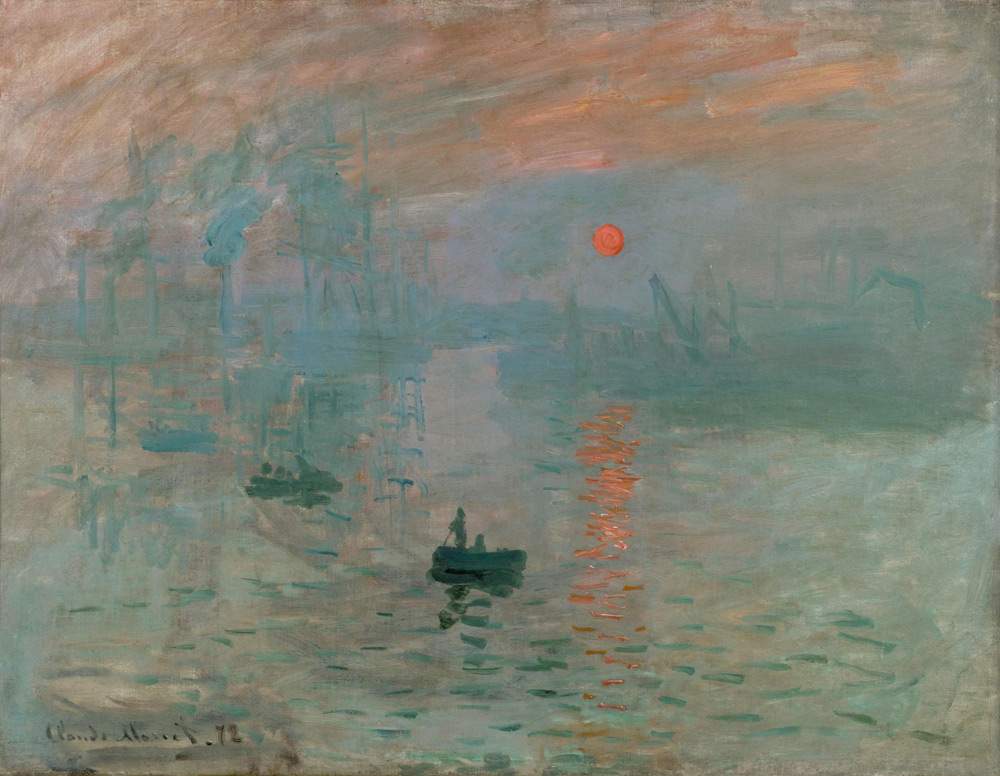 |
| Claude Monet, Impression: soleil levant (1872; oil on canvas, 48 x 63 cm; Paris, Musée Marmottan Monet) |
The innovative and revolutionary way of painting was characteristic of Claude Monet, Pierre-Auguste Renoir (Limoges, 1841 Cagnes-sur-Mer, 1919), Paul Cézanne (Aix-en-Provence, 1839 1906), Edgar Degas (Paris, 1834 1917), Félix Bracquemond (Paris, 1833 Sèvres, 1914), Armand Guillaumin (Paris, 1841 Orly, 1927), Eugène Boudin (Honfleur, 1824 Deauville, 1898), Camille Pissarro (Charlotte Amalie, 1830 Paris, 1903), Alfred Sisley (Paris, 1839 Moret-sur-Loing, 1899), Berthe Morisot (Bourges, 1841 Paris, 1895), a group of then fledgling artists who in 1874 participated in a painting exhibition held at an old Parisian studio on boulevard des Capucines made available by photographer Nadar (Paris, 1820 1910), which opened on April 15 of that year. One hundred and sixty-three works, including paintings, drawings, pastels and watercolors, created by the Société anonyme des artistes peintres, sculpteurs, graveurs, or that anonymous society founded the year before the groundbreaking exhibition by the aforementioned artists, were exhibited. Édouard Manet (Paris, 1832 1883) also followed that strange way of painting, but he did not exhibit at the 1874 exhibition, as he was convinced that the renewal of art should be achieved within official institutions. In contrast, Jean-Frédéric Bazille (Montpellier, 1841 Beaune-la-Rolande, 1870) had himself proposed an independent exhibition, but he died a full four years before Nadar’s review. The public and critics did not welcome the Société anonyme’s exhibition benevolently, but rather panned it.
It was Louis Leroy who, referring precisely to Monet’s painting Impression, soleil levant, wrote a few days after the famous exhibition an article in the magazine Le Charivari: Leroy had visited it in the company of landscape painter Joseph Vincent. In the article we read the dialogue between the two: Ah, there it is, there it is! What does this canvas represent? Look at the catalog. Impression, rising sun. Impression, I was sure, There must be impression in there. And what freedom, what ease of execution! The wallpaper in its embryonic state is even more carefully executed than this painting. But what would Bidault, Boisselier, Bertin have said before this important canvas? Don’t tell me about those lousy painters!!!
The piece testifies to Leroy’s total critique and criticism of inferiority towards the group of emerging artists, but it proved famous because it was this article that coined the term Impressionists. A satirical definition, implying a negative meaning, became a successful designation in the following centuries, capable of attracting thousands of visitors.
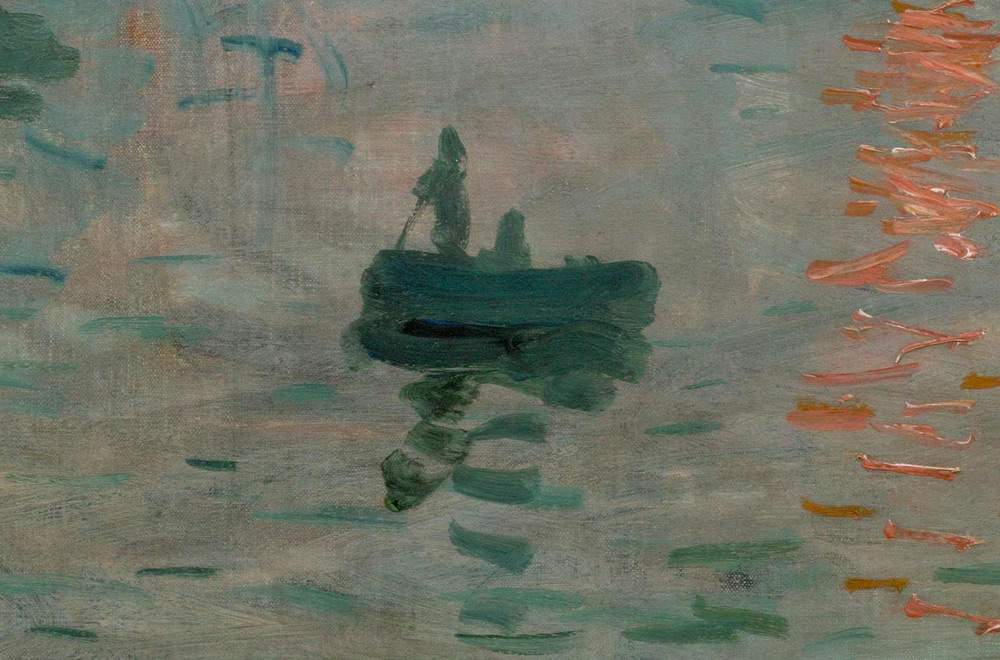 |
| Claude Monet, Impression: soleil levant, detail |
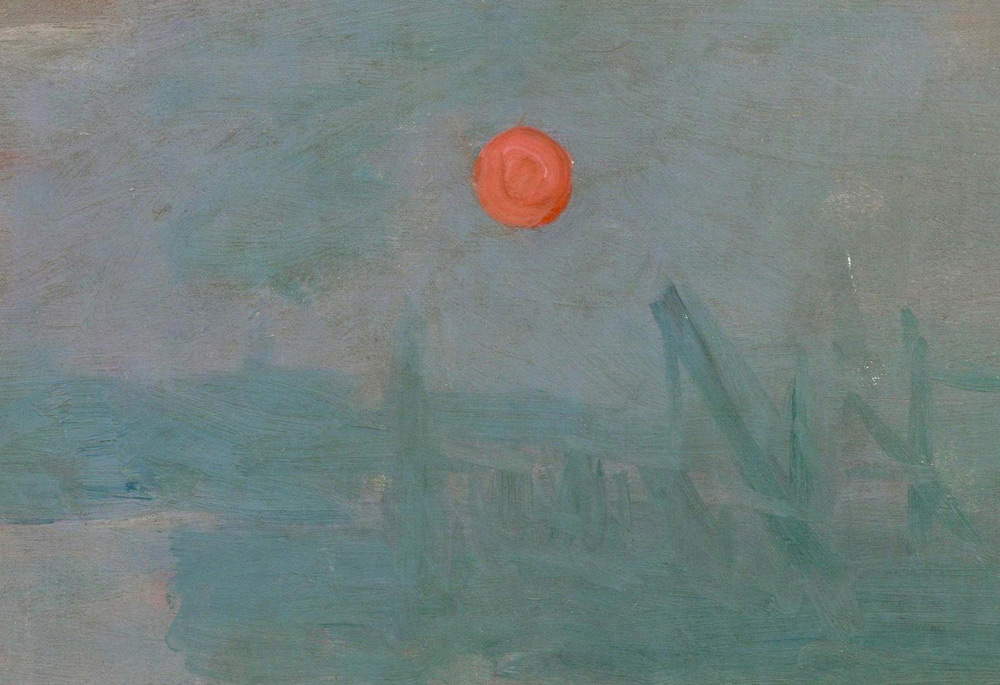 |
| Claude Monet, Impression: soleil levant, detail |
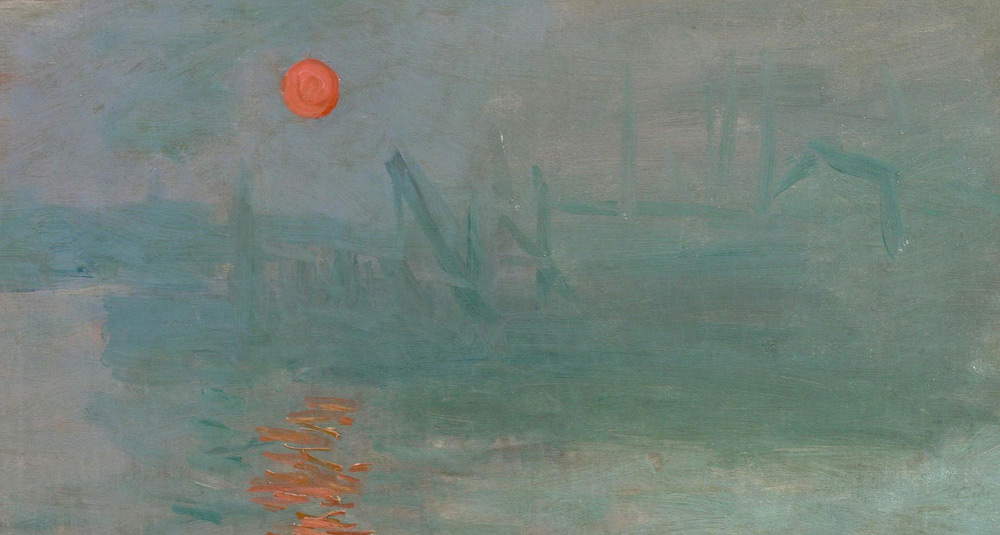 |
| Claude Monet, Impression: soleil levant, detail |
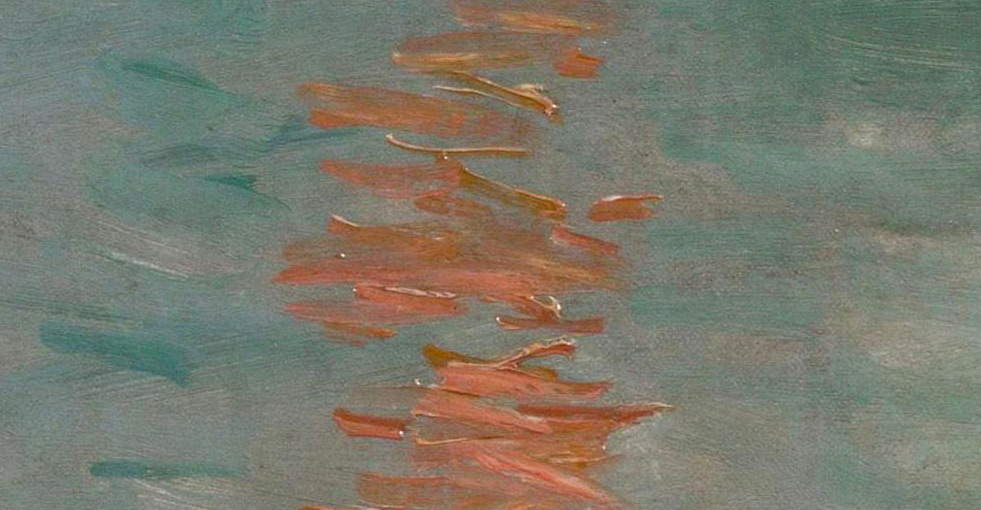 |
| Claude Monet, Impression: soleil levant, detail |
The artists in question refused, however, to be classified under the term Impressionists, as in their view it was too reductive and mocking, as this designation designated the unfinished, un-detailed, evanescent, and instinctive first approach character of their works. On the contrary, their intention was to communicate far beyond the impression of something, and Monet himself stated that the term Impression used in the title of his painting was dictated solely by the creativity of the moment and was in no way meant to allude to the ideal of the new painting.
Over the years, however, they yielded to the name given to them as a result of the progressive success they achieved: in 1877 Renoir convinced the art critic Georges Rivière to publish a weekly magazine that was given the title of L’Impressionniste, and the third exhibition of the group was held at the same time. In Impression, soleil levant, a painting now preserved at the Musée Marmottan in Paris, Monet depicted the port of Le Havre at a precise moment of the day: sunrise, dawn. And it is well understood by the fiery ball of the sun that illuminates with its orange-colored light the degrading tones of blue that make up the entire painting.
The orange reflections of the rising sun seem to float on the water and stand in contrast to the cool blue-gray tones of the sea. The latter are made with short, quick brush strokes capable of depicting the wave-like movement of the water, which conveys to the viewer a feeling of peace and tranquility, while the subtle orange strokes extraordinarily capture the rapidly changing light. Even the sky is colored orange with wider, less dense brush strokes that create a brighter hue than the grayness of the sky: depicted is that rapid transition between night and day, in which the sun is the daily protagonist.
In the background, amidst the morning haze, is the outline of the harbor with its smokestacks and cranes, which in turn are reflected in the sea water; in the foreground, in the center of the painting, is a fishermen’s boat, rendered in a darker shade of blue, followed by two other small boats closer to the harbor. The progressive distance of the latter is rendered pictorially with patches of color that are more shaded than the previous one, but still tending to blue. At lower left is the artist’s signature and date of composition.
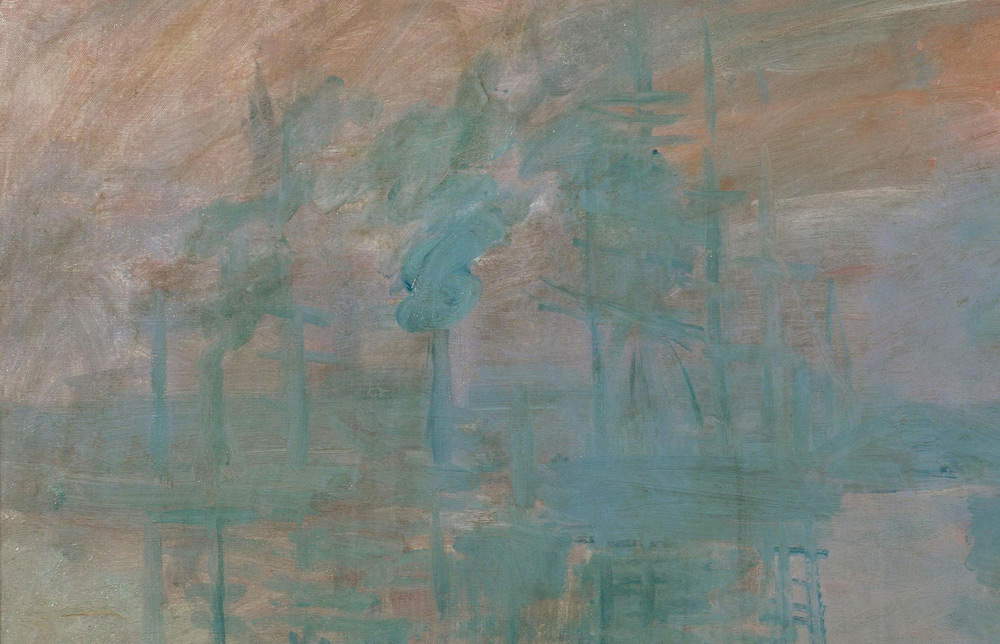 |
| Claude Monet, Impression: soleil levant, detail |
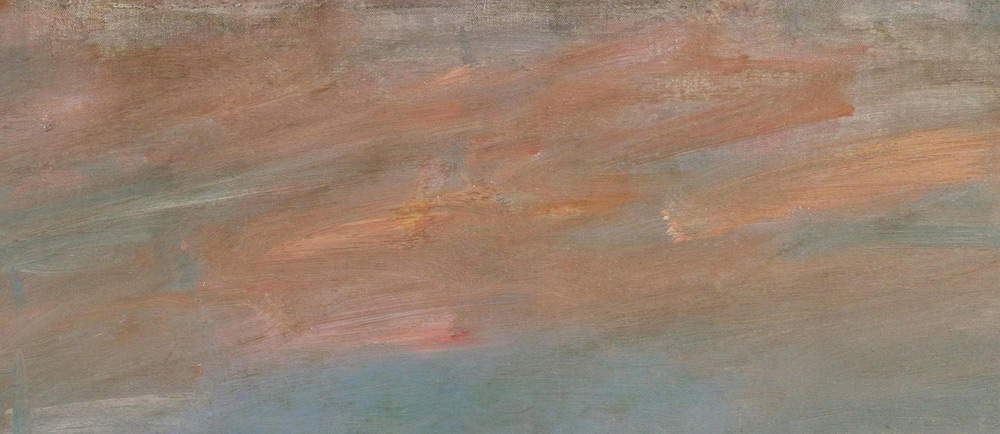 |
| Claude Monet, Impression: soleil levant, detail |
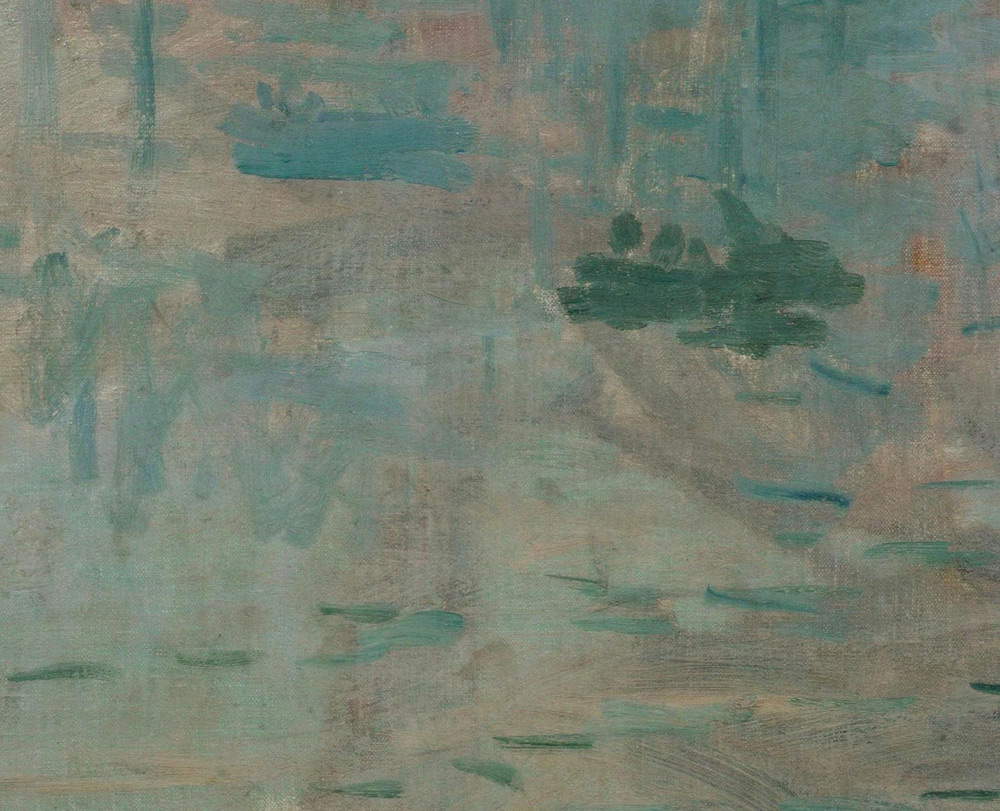 |
| Claude Monet, Impression: soleil levant, detail |
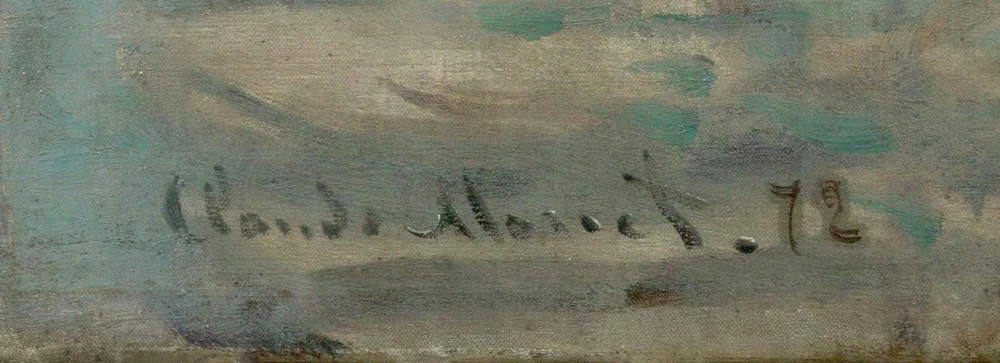 |
| Claude Monet, Impression: soleil levant, detail |
What is thus enhanced in the work is the precise instant of changing light, the intention of wanting to stop time at that particular moment of the day in order to make known, to the viewer of the painting, the sensation or impression that the artist himself felt or heard while admiring that striking landscape. That precise moment was the subject of study by a professor of astrophysics at Texas State University, Donald Olson, a pioneer inforensic astronomy: according to his careful research, the Monet painting in question would have been made on Nov. 13, 1872 at 7:35 a.m. The precise date and time of creation was discovered using geographic analysis of the port of Le Havre, making astronomy calculations related to sunrise, tide levels, and meteorological observations on the sea and sky. In addition, the Texas professor’s team collected all available documentation on the artist and visited the location depicted in the painting to better determine the possible date of creation. Olson reportedly even pinpointed where Monet was at the time the painting was created: in a room on the third floor of theHotel d’Amirauté in Le Havre, from which the famous painter allegedly depicted the scene that appeared before his eyes. To the city of Normandy Monet was strongly attached and knew it very well, having spent his boyhood and adolescence there.
The professor immediately ruled out that the work depicted a sunset, as the sun was in the east, and narrowed down the dates since the sun rises in that exact position only a few times a year, so the researchers on his team used particular books that specified the time of sunrise and the tides and combined them with computer algorithms to arrive at the sensational discovery. Monet, in the course of his artistic activity, gave considerable importance to the study of light, even painting the same subject several times in different light conditions: illustrative is the series of the Cathedrals of Rouen, consisting of about thirty canvases made between 1892 and 1894 whose subject is the facade of Rouen Cathedral at different times of the day and in various climatic conditions. The result is the depiction in different shades of color, each more striking than the last. Everything changes, even the stones affirmed the painter in 1893 in the midst of the creation of the series; what he was looking for was the moment, the influence of the climate on things and the light that characterizes them. He devoted particular interest to the study of the reflections of light on water, as in the case of Impression, soleil levant.
Another significant work from this point of view is Cliff at Étretat at Sunset of 1883, also the subject of Donald Olson’s study, who set its date of completion as February 5. Depicted here is the cliff on the Normandy coast in a particular light: that of sunset given by the bright orange sun that is almost disappearing over the horizon. The sea and the sky have taken on a variegated coloration in which blue, green, yellow in darker and lighter tones and some orange streaks scattered here and there refer to the warm light of the setting sun are mixed. Although the moment depicted has almost come to an end: one can sense this from the now waning position of the sun and the hues of the painting. The light is gradually becoming duller; soon evening will fall. The grandeur of the cliff stands in the viewer’s eyes almost secondary to the artist’s ability to have succeeded in imprinting on the canvas that mixture and harmony of colors that nature shows us at that precise and determined moment.
Already prior to Impression, soleil levant, Monet produced a painting in which the study of reflections on water is significant: in the cases mentioned so far he had depicted the rapid change of light during particular moments of the day, sunrise and sunset. In La Grenouillère, a work from 1869, it is nature that creates reflections on the water. The bathing establishment that stood on the banks of the Seine, not far from Paris, frequented by Parisians generally on Sunday afternoons is depicted in Monet’s characteristic style: short brushstrokes that are not spread or diluted, but rich in color, a lack of drawing due to a desire not to provide defined shapes and contours, and the presence of a body of water on which to play with light and color.
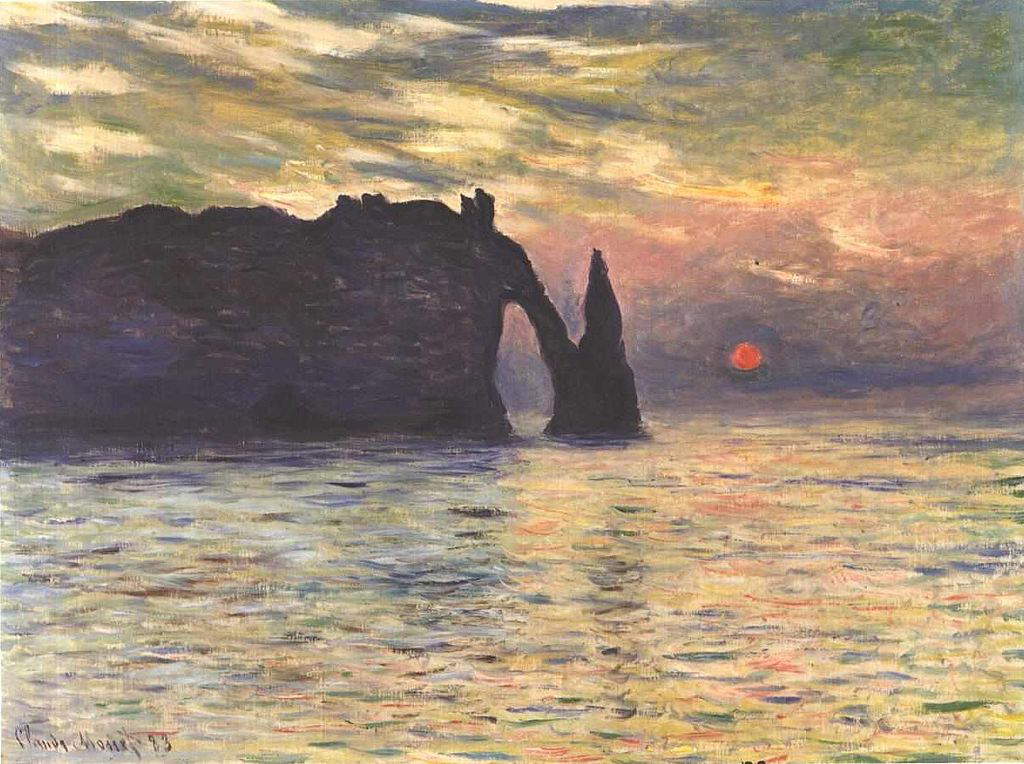 |
| Claude Monet, Cliffs at Étretat at Sunset (1883; oil on canvas, 60.5 x 81.8 cm; Raleigh, North Carolina Museum of Art) |
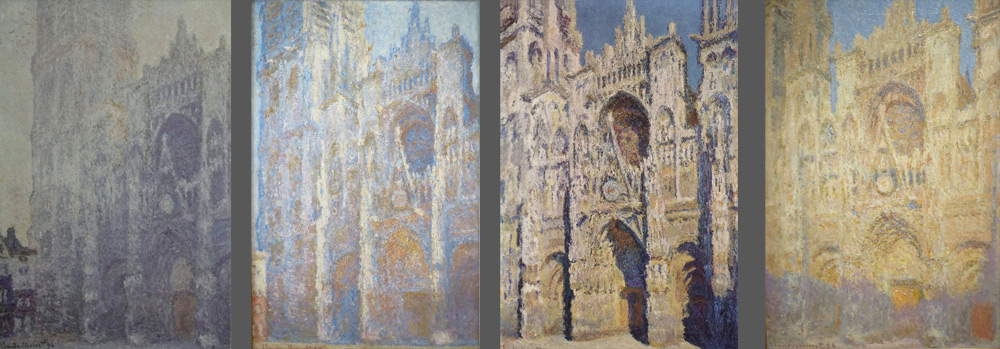 |
| Claude Monet, from left: Rouen Cathedral, Harmonie blanche, in the Early Sun (1893; oil on canvas, 106 x 73 cm; Paris, Musée d’Orsay), Rouen Cathedral at Noon (1894; oil on canvas, 100 x 65 cm; Moscow, Pushkin Museum), Rouen Cathedral in Full Sun (1894; oil on canvas, 107 x 73 cm; Paris, Musée d’Orsay), Rouen Cathedral at Sunset (1894; oil on canvas, 101 x 65 cm; Moscow, Pushkin Museum) |
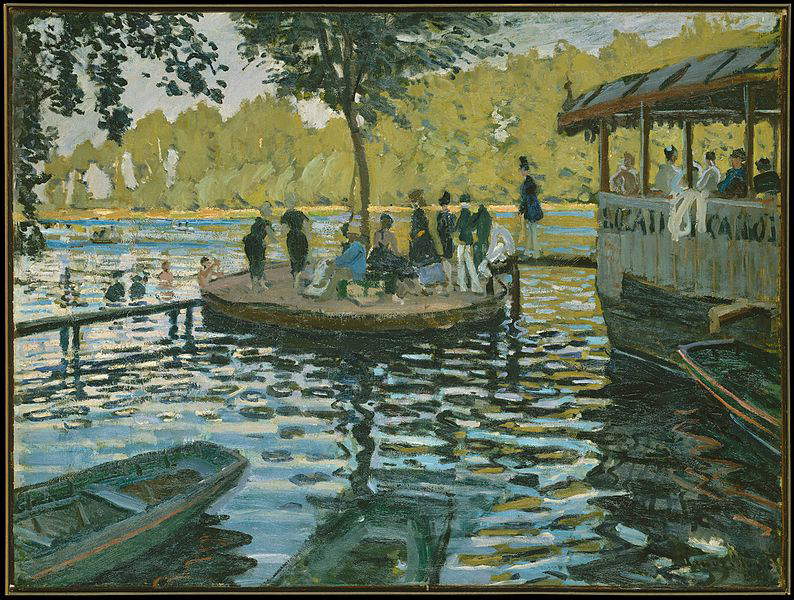 |
| Claude Monet, La Grenouillère (1869; oil on canvas, 74.6 x 99.7 cm; New York, Metropolitan Museum) |
Reflected on the water are the foliage of the trees whose coolness is enjoyed by the small group of people on the small island in the center of the painting: women and men still clothed enjoy the shade of the plants that surround them, although only a few branches are distinctly glimpsed, almost framing the work. However, one can sense the presence of a canopy of trees above the islet, as the water has taken on a coloring with streaks of green: the blue of the water and various shades of green mingle and harmonize the overall tones of the painting. In addition, sunlight filters through the foliage of the trees, creating a special brightness. The people standing on the islet, which is connected to the shore by small piers, are bathers who, standing or sitting, are relaxing in the shade of the plants, and some of them are observing the small group that has already dived into the water.
In the foreground, moored to the shore, are a number of small boats, while on the right is a floating barge with people overlooking the body of water; in the background, on the other shore, a long, tall row of trees lit by the sun is visible. A simple moment that is part of everyday life stopped on canvas by Monet’s painterly skill.
These are just a few of the paintings in which the dominant feature of the famous artist is the reflection of the sun and nature in water: whether sea, river or pond. However, Impression, soleil levant is a fundamental work for Monet’s entire artistic activity, for it is from here that Impressionism can be said to have been born: although, as we have seen, the artist’s style was already clear in earlier works, it is from here that Monet asserts all his greatness in creating a composition based on the extraordinary rendering of color and light and especially its change in a rapid instant. It is true that at the time Louis Leroy’s brutal and public critique was very heavy-handed, but it is also true that it was thanks to this that one of the most fascinating, most evocative, and most beloved artistic movements of the general public was born.
Reference bibliography
- Gérard - Georges Lemaire, Monet, Giunti, 2014
- Nathalia Brodskaya, Monet, Parkstone International, 2011
- Patrizia Vezzosi, InContemporanea. Introduction to Contemporary Art, Alinea Editrice, 2010
- Elena Capretti, Impressionism, Giunti, 2001
- Bernard Denvir, Impressionism, Giunti, 1992
Warning: the translation into English of the original Italian article was created using automatic tools. We undertake to review all articles, but we do not guarantee the total absence of inaccuracies in the translation due to the program. You can find the original by clicking on the ITA button. If you find any mistake,please contact us.



























